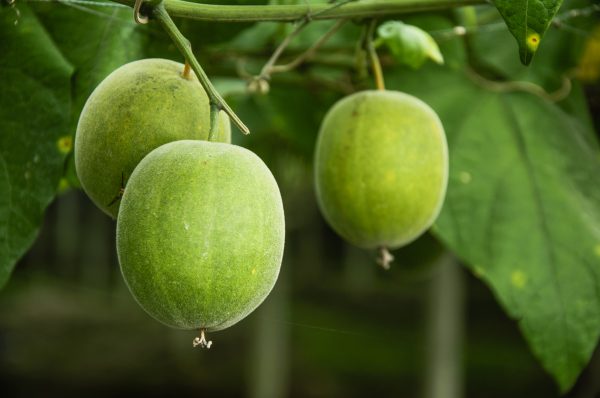
Momordica grosvenori (Lo Han Guo) Monk fruits closeup.
It’s very likely that not one of us could pick out a monk fruit in the produce aisle. It isn’t an attractive fruit, amidst all of the colorful summer beauties. But the monk fruit has my attention these days! It is highly beneficial for health-conscious foodies, ketogenic devotees, and those with diabetes.
Named after the monks who first cultivated it centuries ago, Monk fruit, (or lo han guo), is a small green melon native to southern China. The health benefits of lo han guo have been well-known in Traditional Chinese Medicine for decades, but its sweet little secret has been revealed and is slowly making it into the health-conscious mainstream.
What is so exciting about this little known sweetener?
Monk fruit sweetener comes in several forms and is made from extract derived from the dried fruit. It is 150-250 times sweeter than table sugar, has zero calories, zero carbs, and does not raise blood glucose levels. Aside from these facts, it has health benefits to boast!
Most non-nutritive sweeteners such as Aspartame, Saccharin,
Sucralose and Stevia, can cause side effects like gas, bloating, or allergic reactions. And some artificial sweeteners like Equal and Splenda are controversial. In the case of monk fruit sweeteners, there are no known side effects.
The Food and Drug Administration has deemed monk fruit “generally recognized as safe (GRAS)” for everyone, including pregnant women and children. Even so, because monk fruit is relatively new to the mass market, there are no scientific studies on the effects of long-term use.
Health benefits of monk fruit
1. Safe for diabetes
Monk fruit gets its sweetness from natural compounds called mogrosides. It is safe for those with diabetes because it doesn’t increase blood sugars. That said, foods and drinks that have been sweetened with monk fruit (as well as some monk fruit sweetener blends) may include added sugars and other ingredients that increase carb and calorie counts or affect insulin sensitivity. Make sure and check labels or ask for ingredients lists.
2. Promotes weight loss
Monk fruit has no calories, carbs, or fat, so it may be a great option for anyone watching their waistline or on a keto or paleo diet. You can save substantial calories and carbs by simply substituting monk fruit sweetener for table sugar throughout your day. Again, make sure you consume monk fruit products that don’t include added sugars.
3. Anti-inflammatory properties
According to a 2011 study, monk fruit has been used in traditional Chinese medicine for centuries to make hot drinks that relieve sore throats and reduce phlegm. The fruit’s mogrosides are said to be anti-inflammatory, and may help prevent cancer and keep blood sugar levels stable.
The downsides of monk fruit
Along with its many benefits, monk fruit has a few drawbacks.
It is not easy to find in it’s pure form. Many health food chains and grocery stores such as Sprouts carry it, blended with other natural sugar-free sweeteners. While these versions are also good, there are drawbacks to the added ingredients. The pure form of the fruit can be found at Amazon, here.
Monk fruit is challenging to grow, harvest, and dry. This makes monk fruit sweetener more pricey than non-nutritive sweeteners. It’s also why there are fewer monk fruit sweetener options on your local supermarket shelves.
The taste of monk fruit is very pleasant and a welcome break from the bitter aftertaste of non-nutritive sweeteners.

